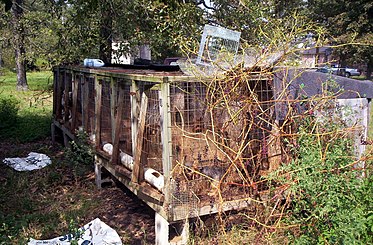
Back Množírna Czech Fábricas de cachorros Spanish Pentutehtailu Finnish パピーミル Japanese 강아지 공장 Korean Broodfokker Dutch Valpefabrikk NB Pseudohodowla Polish 狗隻繁殖場 Chinese
The examples and perspective in this article deal primarily with the United States and do not represent a worldwide view of the subject. (February 2014) |

A puppy mill, also known as a puppy farm, is a commercial dog breeding facility characterized by quick breeding and poor conditions.[1] Although no standardized legal definition for "puppy mill" exists, a definition was established in Avenson v. Zegart in 1984 as "a dog breeding operation in which the health of the dogs is disregarded to maintain a low overhead and maximize profits".[2] They are cited as being a result of increased demand for household pets,[3] especially after World War II.[4] The Veterinary Medical Association of the Humane Society of the United States defines the main characteristics of a puppy mill as "emphasis on quantity over quality, indiscriminate breeding, continuous confinement, lack of human contact and environmental enrichment, poor husbandry, and minimal to no veterinary care."[5]
There are an estimated 10,000 licensed and unlicensed puppy mills in the United States, in total selling more than 2,000,000 puppies annually.[6] In these puppy mills, breeding dogs are often subjected to living the entirety of their lives in cages, which are cramped and uncomfortable for the dog. The whelping bitch's needs often go unmet or ignored. An estimated 500,000 dogs are kept solely for the purpose of breeding in puppy mills.[7][better source needed]
- ^ "Definition of PUPPY MILL". www.merriam-webster.com. Retrieved 2020-02-14.
- ^ Avenson v. Zegart, 577 F. Supp. 958, 960 (United States District Court, D. Minnesota, Sixth Division January 17, 1984) ("A "puppy mill" is a dog breeding operation in which the health of the dogs is disregarded in order to maintain a low overhead and maximize profits.").
- ^ B. Drummond Ayres Jr. (1972-10-23). "Inhumane 'Puppy Mills' a Growing Blight". The New York Times. ISSN 0362-4331. Retrieved 2023-05-12.
- ^ Cite error: The named reference
canis_major_dilemmawas invoked but never defined (see the help page). - ^ "Humane Society Veterinary Medical Association" (PDF). www.hsvma.org. May 2013.
- ^ Humane Society of the United States (2012-08-30). "FAQs" (PDF). Archived from the original (PDF) on 2013-03-09. Retrieved 2012-10-07.
- ^ "Puppy Mills: The Scientific Evidence of Harm They Cause To Dogs – Center for Shelter Dogs". Retrieved 2023-03-06.